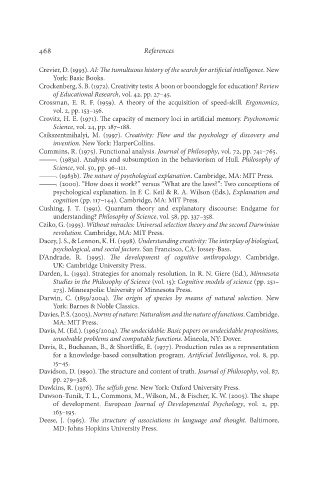Page 485 - Deep Learning
P. 485
468 References
Crevier, D. (1993). AI: The tumultuous history of the search for artificial intelligence. New
York: Basic Books.
Crockenberg, S. B. (1972). Creativity tests: A boon or boondoggle for education? Review
of Educational Research, vol. 42, pp. 27–45.
Crossman, E. R. F. (1959). A theory of the acquisition of speed-skill. Ergonomics,
vol. 2, pp. 153–156.
Crovitz, H. E. (1971). The capacity of memory loci in artificial memory. Psychonomic
Science, vol. 24, pp. 187–188.
Csikszentmihalyi, M. (1997). Creativity: Flow and the psychology of discovery and
invention. New York: HarperCollins.
Cummins, R. (1975). Functional analysis. Journal of Philosophy, vol. 72, pp. 741–765.
———. (1983a). Analysis and subsumption in the behaviorism of Hull. Philosophy of
Science, vol. 50, pp. 96–111.
———. (1983b). The nature of psychological explanation. Cambridge, MA: MIT Press.
———. (2000). “How does it work?” versus “What are the laws?”: Two conceptions of
psychological explanation. In F. C. Keil & R. A. Wilson (Eds.), Explanation and
cognition (pp. 117–144). Cambridge, MA: MIT Press.
Cushing, J. T. (1991). Quantum theory and explanatory discourse: Endgame for
understanding? Philosophy of Science, vol. 58, pp. 337–358.
Cziko, G. (1995). Without miracles: Universal selection theory and the second Darwinian
revolution. Cambridge, MA: MIT Press.
Dacey, J. S., & Lennon, K. H. (1998). Understanding creativity: The interplay of biological,
psychological, and social factors. San Francisco, CA: Jossey-Bass.
D’Andrade, R. (1995). The development of cognitive anthropology. Cambridge,
UK: Cambridge University Press.
Darden, L. (1992). Strategies for anomaly resolution. In R. N. Giere (Ed.), Minnesota
Studies in the Philosophy of Science (vol. 15): Cognitive models of science (pp. 251–
273). Minneapolis: University of Minnesota Press.
Darwin, C. (1859/2004). The origin of species by means of natural selection. New
York: Barnes & Noble Classics.
Davies, P. S. (2003). Norms of nature: Naturalism and the nature of functions. Cambridge,
MA: MIT Press.
Davis, M. (Ed.). (1965/2004). The undecidable: Basic papers on undecidable propositions,
unsolvable problems and computable functions. Mineola, NY: Dover.
Davis, R., Buchanan, B., & Shortliffe, E. (1977). Production rules as a representation
for a knowledge-based consultation program. Artificial Intelligence, vol. 8, pp.
15–45.
Davidson, D. (1990). The structure and content of truth. Journal of Philosophy, vol. 87,
pp. 279–328.
Dawkins, R. (1976). The selfish gene. New York: Oxford University Press.
Dawson-Tunik, T. L., Commons, M., Wilson, M., & Fischer, K. W. (2005). The shape
of development. European Journal of Developmental Psychology, vol. 2, pp.
163–195.
Deese, J. (1965). The structure of associations in language and thought. Baltimore,
MD: Johns Hopkins University Press.

